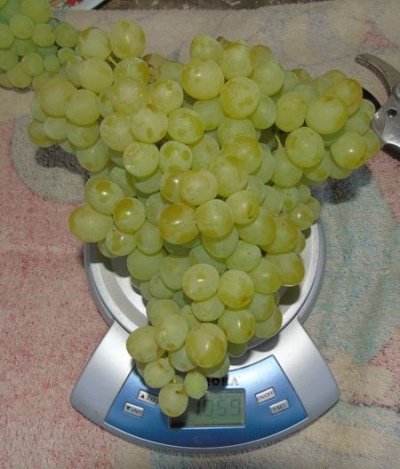
- Authors: Zagorulko Vitaly Vladimirovich
- Appointment: dining room
- Berry color: White
- Taste: with citron-type nutmeg
- With bones: No
- Ripening period: early
- Ripening period, days: 110-115
- Frost resistance, ° C: -21
- Name synonyms: Lemon
- Bunch weight, g: 1200
Grapes as a culture have been known to gardeners for a long time. Despite its long history of use, few manage to find the right approach to this plant. Modern hybrid forms greatly simplify the methods of their reproduction, giving bountiful yields. These varieties include Citronny raisins.
Breeding history
The new hybrid form was developed relatively recently by amateur winegrower Vitaly Vladimirovich Zagorulko. The new variety belongs to the 3rd seedless class. The breeding hybrid is isolated from the same family as Volodar's raisins.
Description
A different name for Citronny raisins is Lemonchik, since there is a slight lemon sourness in the taste. The purpose of the variety is mainly technical. It makes excellent dessert and table wines, but it can also be consumed fresh.
Ripening period
It belongs to the early varieties. Technical ripeness begins in 110-115 days. You can taste the first fruits already in August - early September. However, it should be borne in mind that for regions of Russia with average climatic conditions, it is not recommended to overload the grape bushes. Overloading shifts the growing season.
Bunches
They have a cylindrical-conical shape with medium density. The weight of one bunch can reach 1200 g.
Berries
The shape of the berries varies from oval to oval-ovoid. In fruits of white color, the stone is absent, in the fleshy-juicy pulp, soft rudiments can come across. The weight of one berry reaches 3.5-4 g. The skin is of medium density, practically not felt when eaten.
Taste
The variety is attractive for its harmonious taste, combining nutmeg with citrus notes of a citron type.
Yield
The variety is quite fruitful. From one bush, you can collect from 9 to 12 kg. Possesses good indicators of transportability. Has an extended harvest period.


Growing features
The plant is quite demanding to care for. For cultivation, sunny places are chosen. Draft protection required. Preferably the southern or southeastern side of the site. Also, you should not plant grapes along the walls and next to trees. Any shading negatively affects both the quality of the berries and the successful development of the bush.
Grows well in fertile, well-drained soils. Loamy soil is pre-fertilized. Humus, compost, wood ash are introduced. A year later, re-feeding is carried out. After that, the grapes can be planted in the prepared area.
Watering should be moderate, moderately abundant. It is necessary to exclude stagnation of water in the root system, which can lead to decay of the roots. It is best to arrange drip irrigation in the vineyard.
It is necessary to feed in spring and before winter. Spring feeding consists in the introduction of rotted humus, mineral fertilizers (nitrogen, phosphorus, potassium). This will allow the plant to actively grow shoots and leaves, as well as bring a bountiful harvest.
But you should be careful with mineral fertilizers, especially with nitrogen. Its excess negatively affects the yield and health of the bush. When the soil is fertile, there is no need to add additional nutrition.
Landing
A rather voluminous pit is prepared for planting: 40 by 80 cm and 60 cm deep. The roots should be spacious. The planting hole is covered with layers. Drainage comes first. It can be gravel, broken brick, crushed stone. Then sand, humus, the final layer - fertile soil.
The root collar should be given special attention. It is deepened by 5 cm. After planting the seedling, a small mound is made, the pit is tamped and watered abundantly. Distance between seedlings 2 m, between rows 3 m.
Harvested autumn cuttings have good rooting rates.

Pollination
Kishmish Citron bisexual. Additionally, there is no need to plant pollinator grapes. Fruit ovary occurs almost 100%, without peas. The vine ripens well.
Pruning
Own-rooted plant vigorous. Therefore, timely pruning is required, which is carried out in the fall, after harvest. It is average, up to 6-8 buds. Shoots and shoots that have borne fruit are removed. With this pruning, the grapes bear fruit well.



Frost resistance and the need for shelter
The hybrid is winter-hardy. It tolerates temperatures up to –21 degrees. The vine must be covered for the winter when it drops by 5-10 degrees from this level. This allows you to harden the culture, which has a positive effect on the development of the plant.

Diseases and pests
Citron raisins shows average indicators in the resistance to infectious diseases. Resistance to fungal diseases, mildew and powdery mildew is 3.5 points. Therefore, during the season, preventive treatment is carried out several times.
Birds and insects, especially wasps, do no less harm. They like sweet, fragrant berries very much, so they hide each bunch in a mesh bag.

If a grape is exposed to any disease or insect, this always affects its appearance.
Storage
The bunches lie well, while not losing their presentation and taste for about a month.











































































